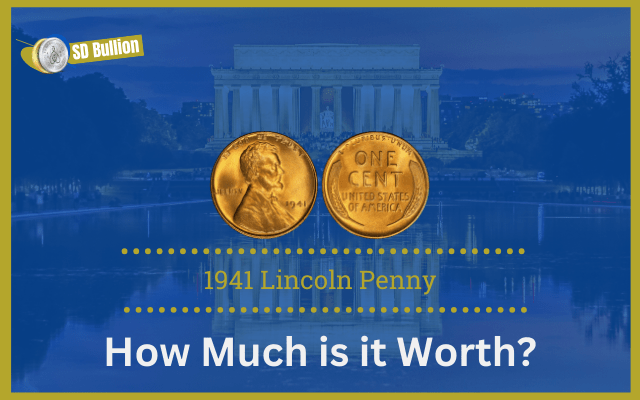Jump to: Factors Affecting The 1941 Penny Value | Design | Historical Context of the 1941 Penny | Composition and Coloration | Grading and Condition | Rarity and Demand | Mint Marks and Varieties | Error Coins
The 1941 Lincoln Wheat Cent is a treasured piece among coin collectors and numismatics. In uncirculated condition, and depending on the variety, this coin can be worth from $3,000 to $30,000!
Prices vary mainly because of its design, condition and surviving population (i.e. rarity).
This article will guide you through every different variety of the 1941 Lincoln Penny, including regular strikes, proof versions and error coins.
Key takeaways
- The value of the 1941 Lincoln Wheat penny is influenced by factors such as design, historical context, rarity, color variation, mint marks, and condition.
- Among the regular issue varieties of the 1941 Lincoln Wheat penny, the 1941-S (San Francisco Mint) in Superb Gem Uncirculated condition (MS-67, MS-68, MS-69) is the most valuable, potentially worth up to $27,500.
- Among the error varieties, the 1941 Double Die Obverse is the most valuable, with prices reaching up to $35,000 for coins graded MS67.
- For the proof variety, the 1941 Lincoln Wheat penny in Superb Gem Uncirculated condition (MS67) can be worth up to $5,250, while the auction record for a Proof graded PR67 is $28,200.
Factors Affecting The 1941 Penny Value
The 1941 Lincoln Wheat penny is part of the long-running Lincoln Cent series, first introduced in 1909 to commemorate President Abraham Lincoln’s 100th birthday. The coin was minted across the Denver, San Francisco, and Philadelphia mints.
The value of a collectible coin relies on its numismatic appeal. So, to understand the prices of a wheat coin, we need to delve into aspects such as design, historical context, significance, as well as rarity, composition, mintmarks, and condition.
Don't miss our list on the 19 most valuable pennies ever sold!
Design
The coin's design features a portrait of President Abraham Lincoln on the obverse side. Above his motif is the American motto IN GOD WE TRUST. On the left is the word LIBERTY, and on the right is the year, with a slight mint mark under, indicating the U.S. Mint facility where the coin was minted.
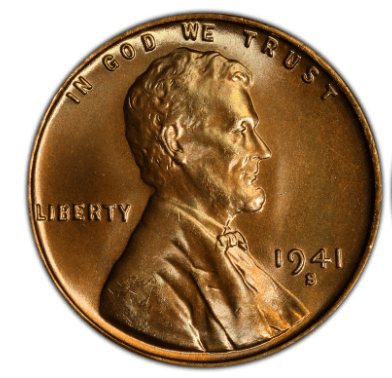
The reverse side shows two wheat ears, clarifying where the term "wheat pennies" comes from. The denomination ONE CENT is at the center, and the inscriptions UNITED STATES OF AMERICA right below it. On top of the coin is the Latin phrase E PLURIBUS UNUM, meaning "out of many, one". Finally, at the bottom are the initials of Victor David Brenner, the coin's designer.
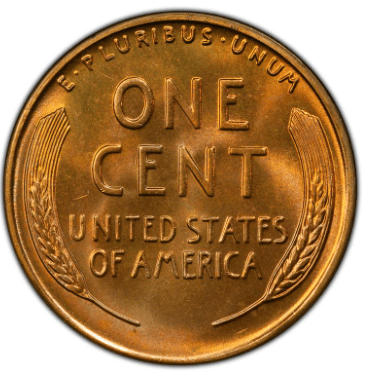
Historical Context of the 1941 Penny
During World War II, copper was removed from American coinage in 1943 to be used in war materials. However, in 1944, the composition of pennies returned to 95% copper and 5% zinc.
The 1941 Lincoln Wheat penny is highly valued and sought after by the majority of collectors and numismatists, as it embodies a piece of American history. Studying these coins is akin to studying the history of the United States itself.
Composition: How Color Affects the Value of A Lincoln Wheat Cent
Copper coins are characterized by their hues as Red, Red-Brown, and Brown. These classifications were established by professional numismatists and are based on how their composition reacts to varying degrees of environmental exposure since it begins oxidizing the moment it hits the air.
Read further to understand what each color means and how the colors of Lincoln cents affect their value:
RED (RD)
A 1969 Penny is mostly made of copper. Therefore, despite the fact that it contains 5% Zinc, it displays a red hue when recently minted. PCGS classifies copper coins as “Red” when they still display 95% or more of their original mint red hue.
Consequently, the coins remain red due to Copper's inherent reddish hue, particularly evident when freshly minted.
And the better the condition, the higher the price a 1969 Penny can fetch in the open market.
RED-BROWN (RB)
PCGS categorizes copper coins as Red and Brown when they grade MS60 or higher and retain between 5% and 95% of their original mint red color. A Red-Brown coin still shows a little bit of its red hue, but oxidation has started to show its colors, indicating a more circulated condition, which brings down the price for most collectors.
BROWN (BN)
PCGS designates Brown for copper coins that display less than 5% of their original mint red color. Certainly, several factors influence the desirability of copper coins, yet many collectors tend to favor the Red ones as they are expected to exhibit less wear compared to their counterparts. While color preference varies among collectors, Red specimens often command higher prices. Which makes Brown fall into a low value in general.
Understanding the distinct colors of copper coins can also serve as a safeguard against counterfeit coins, as each condition typically presents a specific tone that collectors can anticipate.
Grading and Condition: How Mint State Affects Wheat Pennies Value
Collectors highly value Mint State (MS) or uncirculated coins due to their rarity and preservation. Mint State coins generally command a premium over their circulated counterparts.
The Professional Coin Grading Service (PCGS) is one of the leading authorities in coin grading. Coin grading is the process of evaluating and grading a coin's condition based on a numerical scale.
It follows the Sheldon Scale, which was developed by Dr. William Sheldon in 1948. The scale ranges from 1 to 70, with 1 representing a heavily worn and damaged coin and 70 meaning a coin in perfect mint condition with most of its original luster intact.

Coin grading is important in assessing a coin's value because collectors and dealers rely on graded coins to represent their condition accurately such as signs of wear and tear.
An extremely fine grade or uncirculated grade (60-70), typically commands a higher value in the market than circulated grades (1 to 50) due to its rarity and desirability among collectors.
Grading also provides a standardized universal way to communicate a coin's condition, facilitating fair transactions and ensuring market transparency.
Nevertheless, the Lincoln Wheat Cent coin will still retain its face value of approximately 1 cent in an average circulated condition.
Additionally, even in circulated conditions or low rarity cases, graded coins are often more liquid and easier to trade, as their condition is certified by reputable grading services like PCGS, or NGC.
Rarity and Demand: What Drives Up the Value
The rarity of a coin is an important factor in determining its value. Many collectors began their numismatic career with Wheat Ear Lincoln cents, because in circulated condition, "Wheaties" are common in many dates, easy to identify and affordable enough to have a complete set.
Here's a list of all Valuable Wheat Pennies you can find.
Mint Marks and Varieties: The Value Of A Coin According To Its Mint.
The 1941 Lincoln Wheat penny was minted at three locations: Philadelphia (no mint mark), Denver (D mint mark), and San Francisco (S mint mark).
1941 (Philadelphia Mint) 1C, Red, Regular Strike
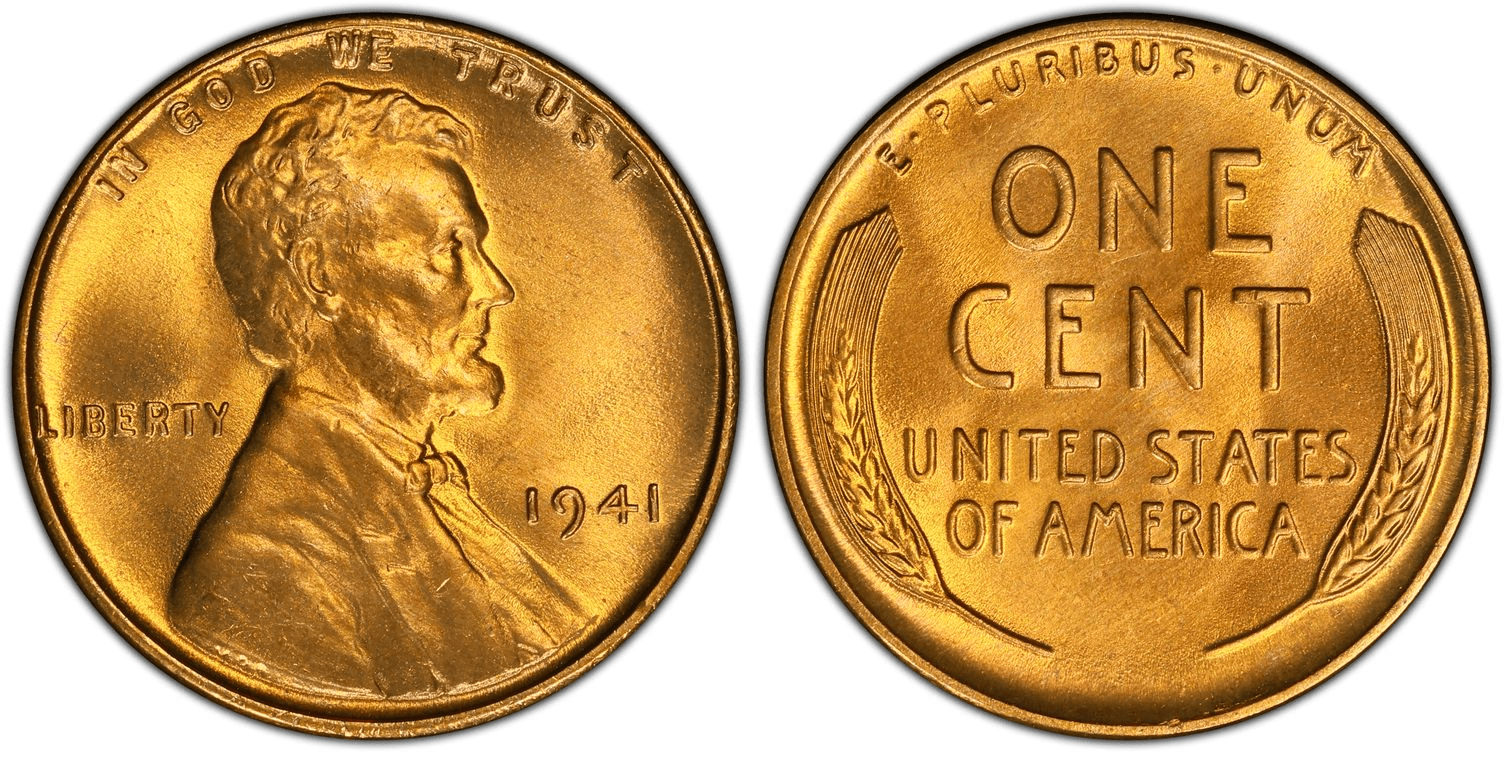
Source // PCGS
In 1941, the Philadelphia branch minted 887,018,000 coins, the largest mintage of all three, with common coins in all grades, but an estimated survival of 15,000 coins in uncirculated condition. Note that Philadelphia issues have no mint mark.
The auction record for this variety is $4,994 for a specimen graded MS65, achieved in 2013. In superb gem condition, the same coin can fetch up to $20,000.
1941-D (Denver Mint) 1C, Red, Regular Strike
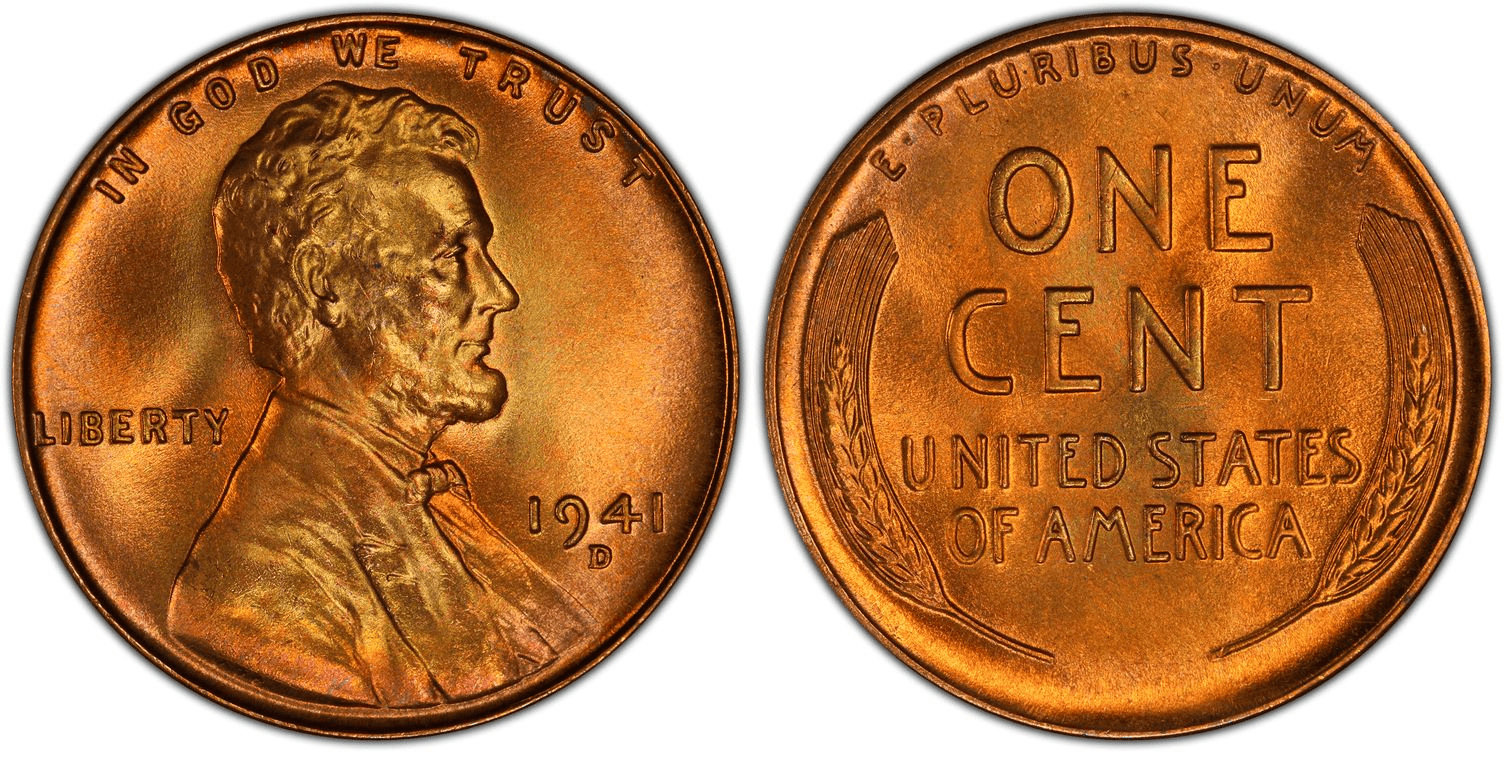
Source // PCGS
The Denver facility minted 128,700,000 coins in 1941, making the 1941-D Lincoln Cent very common in all grades. However, when it comes to Mint State, only 8,000 are estimated to have survived.
An auction record for a coin from this mintage is $6,600 for a coin graded MS68RD, achieved on January 2, 2023, on eBay. However, according to PCGS price guide, in superb gem condition (MS-67, MS-68, MS-69) it can be worth up to $15,000.
1941-S (San Francisco Mint) 1C, Red, Regular Strike

Source // PCGS
The 1941-S Lincoln Cent is the least common issue in the series, and the most valuable. With a mintage of 92,360,000, when it comes to the 1941-S, anything grading higher than MS67 is very scarce.
The auction record for this MS64 coin, sold by Heritage Auctions in 2022, is $3,360.
Additionally, in Superb Gem Uncirculated condition (MS-67, MS-68, MS-69), it can be worth up to $27,500.
1941 (Philadelphia Mint) 1C, Red, Proof
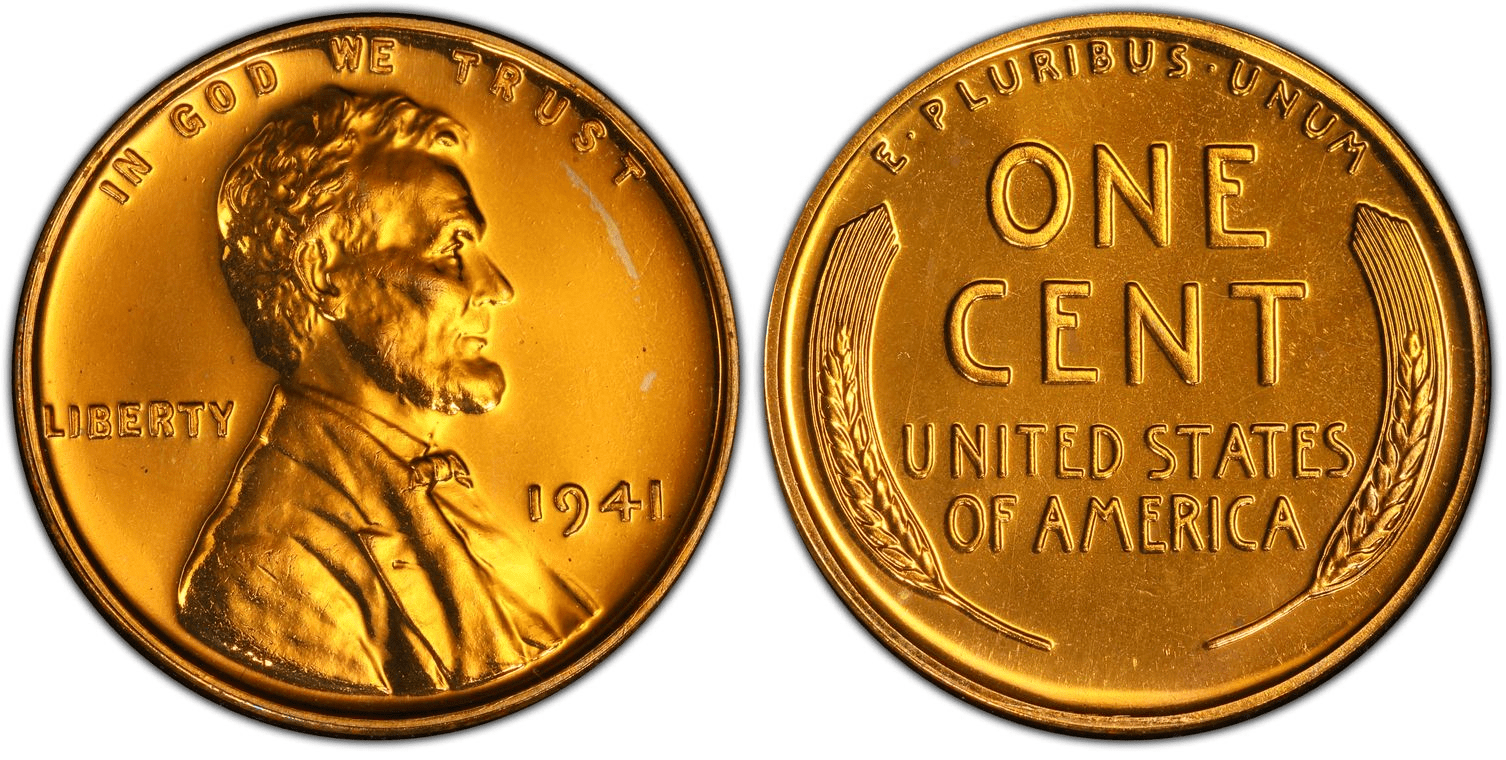
Source // PCGS
With a mintage number of 21,100, in superb gem condition (MS67) this coin can be worth up to $5,250. The auction record for a Proof graded PR67 was $28,200 in 2013, at Heritage Auctions.
Curious to learn more about who is on the penny? Check out our article.
Error Coins
When it comes to errors, the 1941 Double Die Obverse is the most significant error coin within the 1941 Lincoln Wheat penny in terms of price:
1941 1C DDO FS-101, RD (Regular Strike)
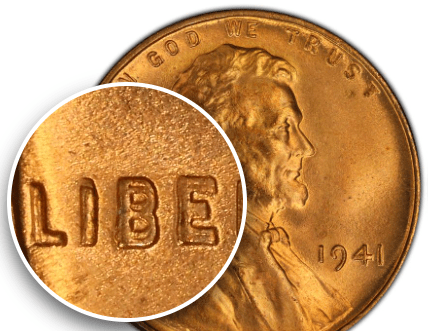
Source // PCGS
The doubling occurs from mistakes in the die-hubbing process. Notice that the result is the coin with a double image on it.
The auction record is $9,200 for a coin graded MS66, achieved in 2010 and in MS67 condition, it can fetch up to $35,000.
Check out our list of penny errors to look for.
Final Thoughts
In this article, you learned that 1941 wheat pennies are not rare in general since they were made in large quantities and can even be found in circulation.
However, some mintmarks, conditions and errors, and historical significance can make them worth money way beyond their face value. We hope this article has equipped you with the necessary knowledge to assess and expect fair value for the 1941 wheat pennies.




